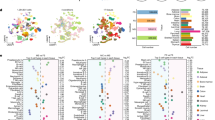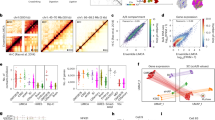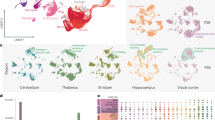Abstract
The past decade has seen the development of powerful techniques to dissect the molecular processes that regulate development. New tools have been used to reveal the basis of cell polarity, morphogen gradients and regulation of signaling in developing animals. Cell biology and developmental biology have become closely intertwined, and many genes that had been thought of as regulators of general cell biological (housekeeping) functions have been shown to act as specific developmental regulators. Vertebrate developmental genetics is now flourishing, with forward and reverse genetics in both zebrafish and the mouse providing new dimensions to our understanding of development.
This is a preview of subscription content, access via your institution
Access options
Subscribe to this journal
Receive 12 print issues and online access
$209.00 per year
only $17.42 per issue
Buy this article
- Purchase on Springer Link
- Instant access to full article PDF
Prices may be subject to local taxes which are calculated during checkout








Similar content being viewed by others
References
Wolpert, L. Do we understand development? Science 266, 571–572 (1994).
Chalfie, M., Tu, Y., Euskirchen, G., Ward, W.W. & Prasher, D.C. Green fluorescent protein as a marker for gene expression. Science 263, 802–805 (1994).
Guo, S. & Kemphues, K.J. Molecular genetics of asymmetric cleavage in the early Caenorhabditis elegans embryo. Curr. Opin. Genet. Dev. 6, 408–415 (1996).
Reese, K.J., Dunn, M.A., Waddle, J.A. & Seydoux, G. Asymmetric segregation of PIE-1 in C. elegans is mediated by two complementary mechanisms that act through separate PIE-1 protein domains. Mol. Cell. 6, 445–455 (2000).
Bilder, D. Cell polarity: squaring the circle. Curr. Biol. 11, R132–R135. (2001).
Lu, B., Ackerman, L., Jan, L.Y. & Jan, Y.N. Modes of protein movement that lead to the asymmetric localization of partner of Numb during Drosophila neuroblast division. Mol. Cell 4, 883–891 (1999).
Suzuki, A. et al. Atypical protein kinase C is involved in the evolutionarily conserved par protein complex and plays a critical role in establishing epithelia-specific junctional structures. J. Cell Biol. 152, 1183–1196 (2001).
Strutt, D.I. Asymmetric localization of Frizzled and the establishment of cell polarity in the Drosophila wing. Mol. Cell 7, 367–375 (2001).
Tree, D.R., Shulman, J.M., Rousset, R., Scott, M.P., Gubb, D. & Axelrod, J.D. Prickle mediates feedback amplification to generate asymmetric planar cell polarity signaling. Cell 109, 371–381 (2002).
Struhl, G. & Basler, K. Organizing activity of wingless protein in Drosophila. Cell 72, 527–540 (1993).
Golic, K.G. & Lindquist, S. The FLP recombinase of yeast catalyzes site-specific recombination in the Drosophila genome. Cell 59, 499–509 (1989).
Brand, A.H. & Perrimon, N. Targeted gene expression as a means of altering cell fates and generating dominant phenotypes. Development 118, 401–415 (1993).
Fischer, J.A, Giniger, E., Maniatis, T. & Ptashne, M. GAL4 activates transcription in Drosophila. Nature 332, 853–856 (1988).
Bellen, H.J., O'Kane, C.J., Wilson, C., Grossniklaus, U., Pearson, R.K. & Gehring, W.J. P-element–mediated enhancer detection: a versatile method to study development in Drosophila. Genes Dev. 3, 1288–1300 (1989).
Zecca, M., Basler, K. & Struhl, G. Sequential organizing activities of engrailed, hedgehog and decapentaplegic in the Drosophila wing. Development 121, 2265–2278 (1995).
Zecca, M., Basler, K. & Struhl, G. Direct and long-range action of a wingless morphogen gradient. Cell 87, 833–844 (1996).
Nellen, D., Burke, R., Struhl, G. & Basler, K. Direct and long-range action of a DPP morphogen gradient. Cell 85, 357–368 (1996).
Strigini, M. & Cohen, S.M. Wingless gradient formation in the Drosophila wing. Curr. Biol. 10, 293–300 (2000).
Lander, A.D., Nie, Q. & Wan, F.Y. Do morphogen gradients arise by diffusion? Dev. Cell 2, 785–796 (2002).
Xu, T. & Rubin, G.M. Analysis of genetic mosaics in developing and adult Drosophila tissues. Development 117, 1223–1237 (1993).
Pan, D. & Rubin, G.M. cAMP-dependent protein kinase and hedgehog act antagonistically in regulating decapentaplegic transcription in Drosophila imaginal discs. Cell 80, 543–552 (1995).
Jiang, J. & Struhl, G. Regulation of the Hedgehog and Wingless signalling pathways by the F-box/WD40-repeat protein Slimb. Nature 391, 493–496 (1998).
Simon, M.A., Bowtell, D.D., Dodson, G.S., Laverty, T.R. & Rubin, G.M. Ras1 and a putative guanine nucleotide exchange factor perform crucial steps in signaling by the Sevenless protein tyrosine kinase. Cell 67, 701–716 (1991).
Karim, F.D., Chang, H.C., Therrien, M., Wassarman, D.A., Laverty, T. & Rubin, G.M. A screen for genes that function downstream of Ras1 during Drosophila eye development. Genetics 143, 315–329 (1996).
Chen, Y. & Struhl, G. Dual roles for patched in sequestering and transducing Hedgehog. Cell 87, 553–563 (1996).
Freeman, M. Feedback control of intercellular signalling in development. Nature 408, 313–319 (2000).
Gerlitz, O. & Basler, K. Wingful, an extracellular feedback inhibitor of Wingless. Genes Dev. 16, 1055–1059 (2002).
Ye, Y. & Fortini, M.E. Proteolysis and developmental signal transduction. Semin. Cell Dev. Biol. 11, 211–221 (2000).
Lai, E.C. Protein degradation: four E3s for the Notch pathway. Curr. Biol. 12, R74–R78 (2002).
Moustakas, A., Souchelnytskyi, S. & Heldin, C.H. Related Smad regulation in TGF-β signal transduction. J. Cell. Sci. 114, 4359–4369 (2001).
Maniatis, T. A ubiquitin ligase complex essential for the NF-κB, Wnt/Wingless, and Hedgehog signaling pathways. Genes Dev. 13, 505–510 (1999).
Dubois, L., Lecourtois, M., Alexandre, C., Hirst, E. & Vincent, J.P. Regulated endocytic routing modulates Wingless signaling in Drosophila embryos. Cell 105, 613–624 (2001).
Lee, J.R., Urban, S., Garvey, C.F. & Freeman, M. Regulated intracellular ligand transport and proteolysis control EGF signal activation in Drosophila. Cell 107, 161–171 (2001).
Sen, J., Goltz, J.S., Konsolaki, M., Schüpbach, T. & Stein, D. Windbeutel is required for function and correct subcellular localization of the Drosophila patterning protein Pipe. Development 127, 5541–5550 (2000).
Sen, J., Goltz, J.S., Stevens, L. & Stein, D. Spatially restricted expression of pipe in the Drosophila egg chamber defines embryonic dorsal–ventral polarity. Cell 95, 471–481 (1998).
Tanaka, K., Kitagawa, Y. & Kadowaki, T. Drosophila segment polarity gene product porcupine stimulates the posttranslational N-glycosylation of Wingless in the endoplasmic reticulum. J. Biol. Chem. 277, 12816–12823 (2002).
Burke, R. et al. Dispatched, a novel sterol-sensing domain protein dedicated to the release of cholesterol-modified Hedgehog from signaling cells. Cell 99, 803–815 (1999).
Keleman, K. et al. Comm sorts Robo to control axon guidance at the Drosophila midline. Cell 110, 415–427 (2002).
Justice, N.J. & Jan, Y.N. Variations on the Notch pathway in neural development. Curr. Opin. Neurobiol. 12, 64–70 (2002).
Moloney, D.J. et al. Fringe is a glycosyltransferase that modifies Notch. Nature 406, 369–375 (2000).
Sisson, J.C., Ho, K.S., Suyama, K. & Scott, M.P. Costal2, a novel kinesin-related protein in the Hedgehog signaling pathway. Cell 90, 235–245 (1997).
Eggenschwiler, J.T., Espinoza, E. & Anderson, K.V. Rab23 is an essential negative regulator of the mouse Sonic hedgehog signalling pathway. Nature 412, 194–198 (2001).
Kmita, M., Fraudeau, N., Herault, Y. & Duboule, D. Serial deletions and duplications suggest a mechanism for the collinearity of Hoxd genes in limbs. Nature 420, 145–150 (2002).
Fuchs, E., Merrill, B.J., Jamora, C. & DasGupta, R. At the roots of a never-ending cycle. Dev. Cell. 1, 13–25 (2001).
Radtke, F. et al. Deficient T cell fate specification in mice with an induced inactivation of Notch1. Immunity 10, 547–558 (1999).
Rosen, B. & Beddington, R.S. Whole-mount in situ hybridization in the mouse embryo: gene expression in three dimensions. Trends Genet. 9, 162–167 (1993).
Beddington, R.S. Induction of a second neural axis by the mouse node. Development 12, 613–620 (1994).
Thomas, P. & Beddington, R. Anterior primitive endoderm may be responsible for patterning the anterior neural plate in the mouse embryo. Curr. Biol. 6, 1487–1496 (1996).
Heasman, J. Morpholino oligos: making sense of antisense? Dev. Biol. 243, 209–214 (2002).
Calegari, F., Haubensak, W., Yang, D., Huttner, W.B. & Buchholz, F. Tissue-specific RNA interference in postimplantation mouse embryos with endoribonuclease-prepared short interfering RNA. Proc. Natl. Acad. Sci. USA 99, 14236–14240 (2002).
Mellitzer, G., Hallonet, M., Chen, L. & Ang, S.L. Spatial and temporal 'knock down' of gene expression by electroporation of double-stranded RNA and morpholinos into early postimplantation mouse embryos. Mech. Dev. 118, 57–63 (2002).
Zhang, J., Talbot, W.S. & Schier, A.F. Positional cloning identifies zebrafish one-eyed pinhead as a permissive EGF-related ligand required during gastrulation. Cell 92, 241–251 (1998).
Kupperman, E., An, S., Osborne, N., Waldron, S. & Stainier, D.Y. A sphingosine-1-phosphate receptor regulates cell migration during vertebrate heart development. Nature 406, 192–195 (2000).
Walsh, E.C. & Stainier, D.Y. UDP-glucose dehydrogenase required for cardiac valve formation in zebrafish. Science 293, 1670–1673 (2001).
Cordes, S.P. & Barsh, G.S. The mouse segmentation gene kr encodes a novel basic domain-leucine zipper transcription factor. Cell 79, 1025–1034 (1994).
Shumacher, A., Faust, C. & Magnuson, T. Positional cloning of a global regulator of anterior–posterior patterning in mice. Nature 383, 250–253 (1996).
Kibar, Z, Voganm K.J., Groulx, N., Justice, M.J., Underhill, D.A. & Gros, P. Ltap, a mammalian homolog of Drosophila Strabismus/Van Gogh, is altered in the mouse neural tube mutant Loop-tail. Nat. Genet. 28, 251–255 (2001).
Hentges, K.E. et al. FRAP/mTOR is required for proliferation and patterning during embryonic development in the mouse. Proc. Natl. Acad. Sci. USA 98, 13796–13801 (2001).
Caspary, T. et al. Mouse Dispatched homolog1 is required for long-range but not juxtacrine Hh signaling. Curr. Biol. 12, 1628–1632 (2002).
Leighton, P.A. et al. Defining brain wiring patterns and mechanisms through gene trapping in mice. Nature 410, 174–179 (2001).
Stanford, W.L., Cohn, J.B. & Cordes, S.P. Gene-trap mutagenesis: past, present and beyond. Nat. Rev. Genet. 2, 756–768 (2001).
Wallis, D. & Muenke, M. Mutations in holoprosencephaly. Hum. Mutat. 16, 99–108 (2000).
van de Wetering, M. et al. The β-catenin/TCF-4 complex imposes a crypt progenitor phenotype on colorectal cancer cells. Cell 111, 241–250 (2002).
Goodrich, L.V. & Scott, M.P. (1998) Hedgehog and patched in neural development and disease. Neuron 21, 1243–1257 (1998).
Anderson, K.V. Toll signaling pathways in the innate immune response. Curr. Opin. Immunol. 12, 13–19 (2000).
Selkoe, D.J. Presenilin, Notch, and the genesis and treatment of Alzheimer's disease. Proc. Natl. Acad. Sci. USA 98, 11039–11041 (2001).
Wolkow, C.A., Kimura, K.D., Lee, M.S. & Ruvkun, G. Regulation of C. elegans life-span by insulin-like signaling in the nervous system. Science 290, 147–150 (2000).
Fraser, A.G., Kamath, R.S., Zipperlen, P., Martinez-Campos, M., Sohrmann, M. & Ahringer, J. Functional genomic analysis of C. elegans chromosome I by systematic RNA interference. Nature 408, 325–330 (2000).
Gonczy, P. et al. Functional genomic analysis of cell division in C. elegans using RNAi of genes on chromosome III. Nature 408, 331–336 (2000).
Furlong, E.E., Andersen, E.C., Null, B., White, K.P. & Scott, M.P. Patterns of gene expression during Drosophila mesoderm development. Science 293, 1629–1633 (2001).
Hughes, C.L. & Kaufman, T.C. RNAi analysis of Deformed, proboscipedia and Sex combs reduced in the milkweed bug Oncopeltus fasciatus: novel roles for Hox genes in the hemipteran head. Development 127, 3683–3694 (2000).
Plasterk, R.H., Izsvak, Z. & Ivics, Z. Resident aliens: the Tc1/mariner superfamily of transposable elements. Trends Genet. 15, 326–332 (1999).
Adler, P.N. Planar signaling and morphogenesis in Drosophila. Dev. Cell 2, 525–535 (2002).
Johnson, R.L., Grenier, J.K. & Scott, M.P. Patched overexpression alters wing disc size and pattern: transcriptional and post-transcriptional effects on hedgehog targets. Development 121, 4161–4170 (1995).
Wilson, V., Rashbass, P. and Beddington, R.S.P. Chimeric analysis of T (Brachyury) gene function. Development 117, 1321–1331 (1993).
Hamada, H., Meno, C., Watanabe, D. & Saijoh, Y. Establishment of vertebrate left–right asymmetry. Nat. Rev. Genet. 3, 103–113 (2002).
Pinson, K.I., Brennan, J., Monkley, S., Avery, B.J. & Skarnes, W.C. An LDL-receptor–related protein mediates Wnt signalling in mice. Nature 407, 535–538 (2000).
Kasarskis, A., Manova, K. & Anderson, K.V. A phenotype-based screen for ENU-induced embryonic lethal mutations in the mouse. Proc. Natl. Acad. Sci. USA 95, 7485–7490 (1998).
Author information
Authors and Affiliations
Corresponding author
Rights and permissions
About this article
Cite this article
Anderson, K., Ingham, P. The transformation of the model organism: a decade of developmental genetics. Nat Genet 33 (Suppl 3), 285–293 (2003). https://doi.org/10.1038/ng1105
Issue Date:
DOI: https://doi.org/10.1038/ng1105
This article is cited by
-
Evaluation of mutagenic susceptibility of different stages in germ cell development of Caenorhabditis elegans using whole genome sequencing
Archives of Toxicology (2023)
-
Evaluation of the effects of acetylcholinesterase inhibitors in the zebrafish touch-evoked response: quantitative vs. qualitative assessment
Environmental Sciences Europe (2020)
-
The Xenopus Embryo: An Ideal Model System to Study Human Ciliopathies
Current Pathobiology Reports (2015)
-
DFLAT: functional annotation for human development
BMC Bioinformatics (2014)
-
RNA isolation method for single embryo transcriptome analysis in zebrafish
BMC Research Notes (2010)



